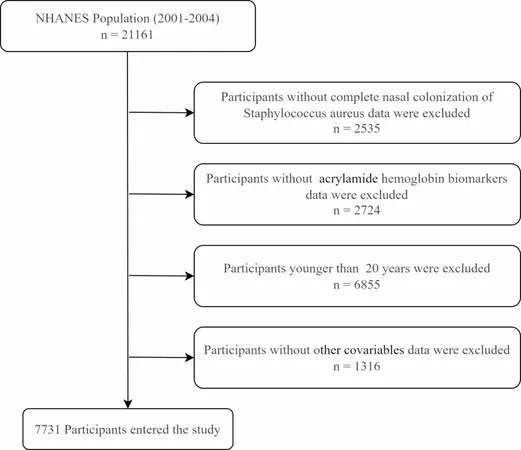
The Surprising Link Between Good Cholesterol and Staphylococcus Aureus Colonization: Insights from NHANES Study
2024-11-04
Author: John Tan
Introduction
Did you know that having high levels of high-density lipoprotein cholesterol (HDL-C), often dubbed "good cholesterol," might protect you from certain infections? A recent investigation into this relationship, using data from the 2001-2004 National Health and Nutrition Examination Survey (NHANES), reveals compelling insights into how HDL-C levels relate to nasal colonization of Staphylococcus aureus—a significant factor for various infectious diseases.
What You Need to Know
High-density lipoprotein cholesterol (HDL-C) is known for its heart-protective qualities. However, emerging research suggests it may also play a role in immune response and infection prevention. Approximately 20-30% of healthy adults are estimated to carry Staphylococcus aureus in their nasal passages continuously, increasing their risk for severe bacterial infections.
The Study Parameters
The analysis included 7,731 participants whose data was part of the NHANES survey. Researchers aimed to explore the association between HDL-C and Staphylococcus aureus colonization. They employed sophisticated statistical analyses, including multivariate logistic regression and restricted cubic splines, to adjust for demographic and lifestyle factors. The findings were revealing: the average HDL-C level recorded was 1.38 ± 0.64 mmol/L, with a nasal colonization rate of 26.2%.
Key Findings
The study unveiled a significant negative correlation between HDL-C and nasal colonization of Staphylococcus aureus. Specifically, for every increase in HDL-C, the odds of nasal colonization decreased. Here are the crucial results: - In the unadjusted model, the odds ratio (OR) for the association was 0.71 (P < 0.001), indicating that higher HDL-C levels were linked to reduced colonization rates. - After adjusting for various factors, the relationship remained strong, with an OR of 0.79 in the fully adjusted model (P = 0.002). - Notably, this protective effect was more pronounced in male participants, who experienced a 38% reduced risk with each increment in HDL-C.
Why It Matters
This research underscores the potential role of HDL-C beyond cardiovascular health, illustrating its importance in immune function and infection risk management. With rising interest in HDL-C and its broader implications, this study could pave the way for new strategies to combat infections, especially in high-risk populations.
What’s Next in Research?
While these findings are significant, further research is needed to establish causation, as this study design is cross-sectional. Future longitudinal studies may provide deeper insights into how sustained changes in HDL-C levels over time can influence bacterial colonization and infection risk.
Conclusion
This NHANES-based study clarifies a previously unexplored relationship between HDL-C and nasal colonization of Staphylococcus aureus, particularly among men. It highlights the potential for HDL-C as a target for interventions aimed at reducing infection risks. Understanding this interaction could shape future public health policies and personal health strategies in managing not just heart disease, but also infectious diseases. Stay tuned as more research unfolds about the fascinating intersections of cholesterol and immune health!

 Brasil (PT)
Brasil (PT)
 Canada (EN)
Canada (EN)
 Chile (ES)
Chile (ES)
 España (ES)
España (ES)
 France (FR)
France (FR)
 Hong Kong (EN)
Hong Kong (EN)
 Italia (IT)
Italia (IT)
 日本 (JA)
日本 (JA)
 Magyarország (HU)
Magyarország (HU)
 Norge (NO)
Norge (NO)
 Polska (PL)
Polska (PL)
 Schweiz (DE)
Schweiz (DE)
 Singapore (EN)
Singapore (EN)
 Sverige (SV)
Sverige (SV)
 Suomi (FI)
Suomi (FI)
 Türkiye (TR)
Türkiye (TR)